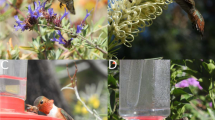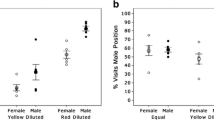Abstract
Hummingbirds compete with other floral visitors for access to floral resources (nectar). Several hummingbird species, including Anna’s (Calypte anna), Black-chinned (Archilochus alexandri), Allen’s (Selasphorus sasin), and Costa’s (Calypte costae) hummingbirds, make extensive use of non-native plants of urban areas of Southern California. Exploitation of urban ornamentals may expose hummingbirds to increased interactions with invasive Argentine ants (Linepithema humile), which are also frequently found foraging on flowers in such habitats. Here, we investigated the mechanisms by which hummingbirds interact with invasive ants at nectar resources in a series of aviary and wild experiments. When given a choice, hummingbirds avoided flowers and feeders with ants in or feeding at a sucrose solution. We identified specific ant-derived cues (visual, tactile, and gustatory) which are sufficient to elicit changes in bird foraging. Tactile and gustatory cues appeared to play the strongest role in mediating interactions with Argentine ants, with visual cues alone not enough to deter hummingbirds from feeding at sugar resources with ants. Our experiments provide support for interference competition at floral resources, where ants limit the birds’ access to flowers and feeders.
Significance statement
Hummingbirds and invasive Argentine ants both visit and exploit floral resources. However, hummingbirds avoid nectar sources that are occupied by ants. Here, we detail a series of mechanistic experiments to determine the proximate cause of this avoidance behavior. We found that the touch and taste of ants is strongly aversive to both wild, free-foraging and aviary hummingbirds. In urban environments and under low water situations, Argentine ants and hummingbirds come into frequent competition for the same few flowers. This competition leads to changes in foraging behavior and may have negative effects on hummingbirds.



Similar content being viewed by others
References
Bacon I, Hurly TA, Healy SD (2011) Hummingbirds choose not to rely on good taste: information use during foraging. Behav Ecol 22:471–477
Baldwin MW, Toda Y, Nakagita T, O'Connell MJ, Klasing KC, Misaka T, Edwards SV, Liberles SD (2014) Evolution of sweet taste perception in hummingbirds by transformation of the ancestral umami receptor. Science 345:929–933
Beal FEF, McAtee (1912) Food of some well-known birds of forest, farm, and garden. US Dept Agr Farmer’s Bull 506:1–35
Buys B (1987) Competition for nectar between Argentine ants (Iridomyrmex humilis) and honeybees (Apis mellifera) on black ironbark (Eucalyptus sideroxylon). S Afr J Zool 22:173–174
Carpenter FL (1979) Competition between hummingbirds and insects for nectar. Am Zool 19:1105–1114
Clark CJ, Russell SM (2012) Anna’s hummingbird (Calypte anna). In: Poole A (ed) Birds of North America online. Cornell lab of ornithology, Ithaca
Clark F (1902) Food of Anna’s hummingbird. Condor 5:18
Dakin R, Fellows TK, Altshuler DL (2016) Visual guidance of forward flight in hummingbirds reveals control based on image features instead of pattern velocity. P Natl Acad Sci USA 113:8849–8854
de Vega C, Herrera CM (2012) Relationships among nectar-dwelling yeasts, flowers and ants: patterns and incidence on nectar traits. Oikos 121:1878–1888
Deneubourg JL, Aron S, Goss S, Pasteels JM (1990) The self-organizing exploratory pattern of the Argentine ant. J Insect Behav 3:159–168
Dutton EM, Frederickson ME (2012) Why ant pollination is rare: new evidence and implications of the antibiotic hypothesis. Arthropod-Plant Inte 6:561–569
Ewald P, Carpenter FL (1978) Territorial responses to energy manipulations in the Anna hummingbird. Oecologia 31:277–292
Feinsinger P, Colwell RK (1978) Community organization among neotropical nectar-feeding birds. Am Zool 18:779–795
Fleming PA, Bakken BH, Lotz CN, Nicolson SW (2004) Concentration and temperature effects on sugar intake and preferences in a sunbird and a hummingbird. Funct Ecol 18:223–232
George MW (1980) Hummingbird foraging behavior at Malvaviscus arboreus var. drummondii. Auk 97:790–794
Gill FB (1988) Trapline foraging by hermit hummingbirds: competition for an undefended, renewable resource. Ecology 69:1933–1942
Gill FB, Mack AL, Ray RT (1982) Competition between hermit hummingbirds Phaethorninae and insects for nectar in a costa Rican rain forest. Ibis 124:44–49
Goldsmith KM, Goldsmith TH (1982) Sense of smell in the black-chinned hummingbird. Condor 84:237–238
Goller B, Altshuler DL (2014) Hummingbirds control hovering flight by stabilizing visual motion. P Natl Acad Sci USA 111:18375–18380
Goller B, Segre PS, Middleton KM, Dickinson MH, Altshuler DL (2017) Visual sensory signals dominate tactile cues during docked feeding in hummingbirds. Front Neurosci 11:622
Grant KA, Grant V (1968) Hummingbirds and their flowers. Columbia University Press, New York
Grant V, Grant KA (1966) Records of hummingbird pollination in the western American flora: I. Some California plant species. Aliso 6:51–66
Hanna C, Naughton I, Boser C, Alarcón R, Hung K-LJ, Holway DA (2015) Floral visitation by the Argentine ant reduces bee visitation and plant seed set. Ecology 96:222–230
Hansen DM, Muller CB (2009) Invasive ants disrupt gecko pollination and seed dispersal of the endangered plant Roussea simplex in Mauritius. Biotropica 41:202–208
Harris-Haller T, Harris SW (1991) Experiments with Allen’s and Anna’s hummingbirds at sugar water feeders in spring. West Birds 22:175–188
Healy SD, Hurly TA (2003) Cognitive ecology: foraging in hummingbirds as a model system. Adv Stud Behav 32:325–359
Hölldobler B, Wilson EO (1990) The ants. Harvard University Press, Cambridge
Holway DA (1995) Distribution of the Argentine ant (Linepithema humile) in northern California. Conserv Biol 9:1634–1637
Hurly TA (1996) Spatial memory in rufous hummingbirds: memory for rewarded and non-rewarded sites. Anim Behav 51:177–183
Ioale P, Papi F (1989) Olfactory-bulb size, odor discrimination and magnetic insensitivity in hummingbirds. Physiol Behav 45:995–999
Junker RR, Bleil R, Daehler CC, Bluethgen N (2010) Intra-floral resource partitioning between endemic and invasive flower visitors: consequences for pollinator effectiveness. Ecol Entomol 35:760–767
Knudsen JT, Tollsten L, Groth I, Bergstrom G, Raguso RA (2004) Trends in floral scent chemistry in pollination syndromes: floral scent composition in hummingbird-pollinated taxa. Bot J Linn Soc 146:191–199
Kuznetsova A, Brockhoff PB, Christensen RHB (2013) lmerTest: tests for random and fixed effects for linear mixed effect models (lmer objects of lme4 package). R package version 1:2–1 http://CRAN.R-project.org/package=lmerTest
Lach L (2005) Interference and exploitation competition of three nectar-thieving invasive ant species. Insect Soc 52:257–262
Lach L (2008) Argentine ants displace floral arthropods in a biodiversity hotspot. Divers Distrib 14:281–290
Legg K, Pitelka FA (1956) Ecologic overlap of Allen’s and Anna’s hummingbirds nesting at Santa Cruz, California. Condor 58:393–405
LeVan KE, Hung KL, McCann KR, Ludka JT, Holway DA (2014) Floral visitation by the Argentine ant reduces pollinator visitation and seed set in the coast barrel cactus, Ferocactus viridescens. Oecologia 174:163–171
Ludka J, Levan KE, Holway DA (2015) Infiltration of a facultative ant-plant mutualism by the introduced Argentine ant: effects on mutualist diversity and mutualism benefits. Ecol Entomol 40:437–443
Martinez Del Rio C (1990) Sugar preferences in hummingbirds: the influence of subtle chemical differences on food choice. Condor 92:1022–1030
Core Team R (2016) R: a language and environment for statistical computing. R Foundation for Statistical Computing, Vienna http://www.R-project.org/
Rico-Gray V, Oliveira P (2007) The ecology and evolution of ant-plant interactions. University of Chicago Press, Chicago
Sidhu CS, Wilson Rankin EE (2016) Honey bees avoiding ant harassment at flowers using scent cues. Environ Entomol 45:420–426
Slauson LA (2000) Pollination biology of two chiropterophilous agaves in Arizona. Am J Bot 87:825–836
Stiles FG (1976) Taste preferences, color preferences, and flower choice in hummingbirds. Condor 78:10–26
Stiles GF, Wolf LL (1970) Hummingbird territoriality at a tropical flowering tree. Auk 87:467–491
Suarez AV, Bolger DT, Case TJ (1998) Effects of fragmentation and invasion on native ant communities in coastal southern California. Ecology 79:2041–2056
Temeles EJ, Kress WJ (2010) Mate choice and mate competition by a tropical hummingbird at a floral resource. Proc R Soc Lond B 277:1607–1613
Thomas CD, Lackie PM, Brisco MJ, Hepper DN (1986) Interactions between hummingbirds and butterflies at a Hamelia patens bush. Biotropica 18:161–165
Vannette RL, Gauthier M-PL, Fukami T (2012) Nectar bacteria, but not yeast, weaken a plant–pollinator mutualism. Proc R Soc B 280:2122601
Acknowledgements
The authors thank S.K. Barney, S. O’Neil, C.S. Sidhu, and two anonymous reviewers for their constructive comments on this manuscript.
Funding
Funding was provided in part from the US Department of Agriculture National Institute of Food and Agriculture Hatch # CA-R-ENT-5091-H (EWR).
Author information
Authors and Affiliations
Corresponding author
Ethics declarations
Conflict of interest
There are no conflicts of interest to report.
Ethical approval
This study followed all applicable national and institutional guidelines for the care and use of animals and was approved by the University of California, Riverside Institutional Animal Care and Use Committee (IACUC protocol #20130018). Hummingbirds were captured from the wild on the UCR campus under USFWS Bird Banding permit #23516 and CA Fish and Wildlife Permit #SC-006598.
Additional information
Communicated by D. Rubenstein
Electronic supplementary material
ESM 1
(DOCX 99 kb)
Rights and permissions
About this article
Cite this article
Rankin, D.T., Clark, C.J. & Wilson Rankin, E.E. Hummingbirds use taste and touch to discriminate against nectar resources that contain Argentine ants. Behav Ecol Sociobiol 72, 44 (2018). https://doi.org/10.1007/s00265-018-2456-z
Received:
Revised:
Accepted:
Published:
DOI: https://doi.org/10.1007/s00265-018-2456-z




